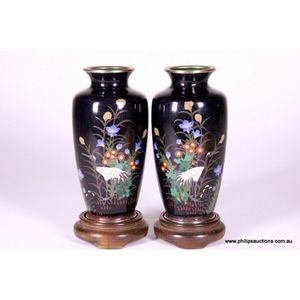Royal Doulton Stoneware Vases, 1922+
You must be a subscriber, and be logged in to view price and dealer details.
Subscribe Now to view actual auction price for this item
When you subscribe, you have the option of setting the currency in which to display prices to $Au, $US, $NZ or Stg.
- Salt Glazed - Salt glazing involves throwing salt into the kiln when it is at its highest temperature, usually around 2,300 to 2,400 degrees Fahrenheit (1,260 to 1,320 degrees Celsius). The salt vaporizes and forms a glaze on the surface of the pottery, creating a range of effects depending on how the salt is applied and the firing conditions. This glazing method was first developed in Germany in the 15th century and quickly became popular throughout Europe and North America. It was particularly popular for making stoneware pottery, such as jugs, crocks, and other utilitarian objects.
Salt glazes can produce a range of colors, including gray, brown, blue, and even pink or purple in some cases. The texture of the glaze is typically rough and pebbled, with a matte or satin finish. The process of salt glazing can be unpredictable, with variations in temperature and salt application leading to subtle variations in the finished product.
Salt glazing is still used by potters and ceramic artists although it is less common than it was in the past. - Frieze - An architectural term denoting the flat, shaped or convex horizontal surface of furniture, between the architrave and the cornice, usually found on a cabinet or bookcase, or on desks and tables where it may include drawers, the area between the top and the legs. In ceramics, the term refers to the banding, of usually a repeating pattern, on the rims of plates and vases.
- Tubelined - In tubelined decoration, a thin line of clay is piped on to the surface of the object through a nozzle to define the design outlines, then the glazes are poured into the areas of the object that are created behind the shallow "dams" formed by the tube-lined decoration.
Tubelined decoration was extensively used by Moorcroft Pottery. It was an expensive decorating technique, owing to the many possibilities of error in manufacture.
This item has been included into following indexes:
Visually similar items

Large vintage red Venetian glass vase, with gilding & applied floral decoration, 38 cm high approx

A pair of Japanese cloisonne vases, mid 20th century, the small baluster vases with waisted necks, white metal rims decorated with auspicious red crested cranes amidst coloured naturalistic foliage upon a ink blue black ground, rich green to the interior;

Doulton Lambeth, pair of stoneware vases, all over floral design in gilt and turquoise, impressed factory marks to undersides (2), height 47 cm. Provenance: from 'Turin Ville' sale, Scone, c. 1930

A pair of Victorian Charles Meigh Neo-Classical revival, black ground ceramic vases, English, circa 1880. 41 cm high
